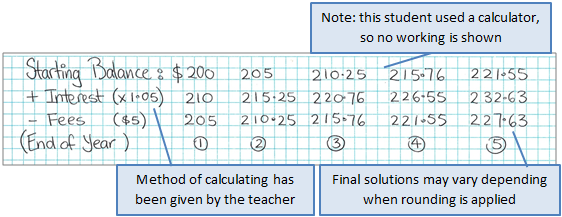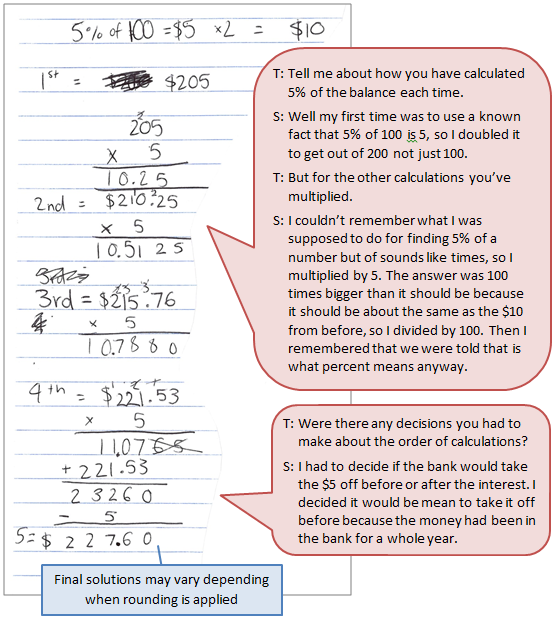The purpose of this activity is to engage students in solving a problem involving decimals (currency) and percentages.
This activity assumes the students have experience in the following areas:
- Calculating percentages of amounts.
- Creating algorithms for iterative arithmetic processes (computational thinking).
- Solving problems with simple compound interest.
The problem is sufficiently open ended to allow the students freedom of choice in their approach. It may be scaffolded with guidance that leads to a solution, and/or the students might be given the opportunity to solve the problem independently.
The example responses at the end of the resource give an indication of the kind of response to expect from students who approach the problem in particular ways.

Gabby is opening a savings account with $200.
The bank pays 5% interest on the balance each year and charges $5 fees at the end of each year.
If she doesn't do anything else with her account, what will the balance be after five years?
The following prompts illustrate how this activity can be structured around the phases of the Mathematics Investigation Cycle.
Make sense
Introduce the problem. Allow students time to read it and discuss in pairs or small groups.
- Do I understand the situation and the words? (Students may need support to understand the meaning of interest and how it is calculated in a compound fashion.)
- What maths will I need to solve this problem? (Students need to be able to add 5% to a base amount.)
- Does this look/sound like a problem I have worked on before?
- Where else in my life/the world can I see this happen? (Exponential growth occurs in everyday contexts, like the spread of viruses and population growth.)
- Is all the information that I need available? Will I need other information?
- What will my solution look like?
Plan approach
Discuss ideas about how to solve the problem. Emphasise that, in the planning phase, you want students to say how they would solve the problem, not to actually solve it.
- What strategies will be helpful to solving this problem? (Creating a table is a useful way to organise the calculations.)
- Which tools might be useful? (A spreadsheet could be used to ease calculation burden and organise the data.
- Do I expect there to be a pattern to how the amount in the account grows? Why do I expect that?
- How might the pattern be helpful for making a prediction?
Take action
Allow students time to work through their strategy and find a solution to the problem.
- Have I recorded my calculations in a way that helps me to see any patterns?
- Are there any patterns?
- How might I describe the pattern?
- Does my solution answer the question?
- Is there another possible answer or way to solve it?
Convince yourself and others
Allow students time to check their answers and then either have them pair share with other groups or ask for volunteers to share their solution with the class.
- What is the solution?
- Is my working clear for someone else to follow?
- How would I convince someone else I am correct?
- Could I have solved the problem in a more efficient way?
- Which ideas or tools worked well in my investigation?
- What could I try differently next time?
- How would I adapt my strategies if some aspects of the problem changed? (Starting amount, interest rate, fees.)
- What maths was useful in solving this problem? What maths do I need to learn more about?
Examples of work
Work sample 1
The student systematically follows a sequence of appropriate calculations, organised in a table, to create a solution.
Click on the image to enlarge it. Click again to close.
Work sample 2
The student finds a solution set to the problem, using the patterns and relationships described. They allow for different forms of rounding.

